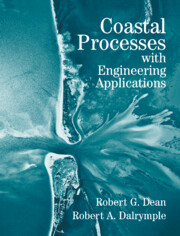Book contents
- Frontmatter
- Contents
- Preface
- Acknowledgments
- PART ONE INTRODUCTION TO COASTAL PROCESSES
- PART TWO HYDRODYNAMICS OF THE COASTAL ZONE
- PART THREE COASTAL RESPONSE
- 6 Field Measurement Techniques and Analysis
- 7 Equilibrium Beach Profiles
- 8 Sediment Transport
- 9 Miscellaneous Coastal Features
- 10 Modeling of Beaches and Shorelines
- PART FOUR SHORELINE MODIFICATION AND ANALYSIS
- Author Index
- Subject Index
8 - Sediment Transport
Published online by Cambridge University Press: 29 May 2010
- Frontmatter
- Contents
- Preface
- Acknowledgments
- PART ONE INTRODUCTION TO COASTAL PROCESSES
- PART TWO HYDRODYNAMICS OF THE COASTAL ZONE
- PART THREE COASTAL RESPONSE
- 6 Field Measurement Techniques and Analysis
- 7 Equilibrium Beach Profiles
- 8 Sediment Transport
- 9 Miscellaneous Coastal Features
- 10 Modeling of Beaches and Shorelines
- PART FOUR SHORELINE MODIFICATION AND ANALYSIS
- Author Index
- Subject Index
Summary
In 1927, a detached offshore breakwater was built 1000 ft off the coast of Santa Barbara, California, to provide protection for a harbor. Within 1 year, a large amount of sand accumulated behind the structure, threatening to shoal the deep-water end of the harbor. A 600-ft extension of the breakwater, attaching it to the western shoreline, was constructed in 1930 to prevent the encroachment of sand from the west into the harbor. Subsequent updrift impoundment of sand by this extension formed what is now called Leadbetter Beach, which is shown in Figure 8.1. This wide recreation beach was caused by the approximately 270,000 yd3 (200,000 m3) of sand transported annually by the waves around the rocky headlands to the west (and updrift) of the harbor. (A volume of 270,000 yd3 of sand is a large load to be moved per year by the waves. To grasp this figure, one would need to imagine filling a football field with a pile of sand 150 ft (46 m) high each year!) By 1931, sand was being transported along the offshore portion of the breakwater and deposited in the navigational channel, threatening to seal off the harbor.
The almost total trapping of sand by the Santa Barbara breakwater caused serious erosion to the sandy beaches downdrift of the harbor, for these beaches no longer received their annual supply of material. (This led to the first court case on “sand rights” in the United States – the Miramar case.) Since 1935, the harbor has been dredged.
- Type
- Chapter
- Information
- Coastal Processes with Engineering Applications , pp. 210 - 274Publisher: Cambridge University PressPrint publication year: 2001



